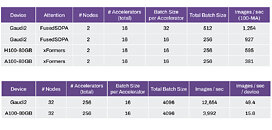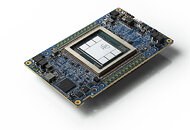- Joined
- Oct 9, 2007
- Messages
- 47,297 (7.53/day)
- Location
- Hyderabad, India
| System Name | RBMK-1000 |
|---|---|
| Processor | AMD Ryzen 7 5700G |
| Motherboard | ASUS ROG Strix B450-E Gaming |
| Cooling | DeepCool Gammax L240 V2 |
| Memory | 2x 8GB G.Skill Sniper X |
| Video Card(s) | Palit GeForce RTX 2080 SUPER GameRock |
| Storage | Western Digital Black NVMe 512GB |
| Display(s) | BenQ 1440p 60 Hz 27-inch |
| Case | Corsair Carbide 100R |
| Audio Device(s) | ASUS SupremeFX S1220A |
| Power Supply | Cooler Master MWE Gold 650W |
| Mouse | ASUS ROG Strix Impact |
| Keyboard | Gamdias Hermes E2 |
| Software | Windows 11 Pro |
Stability AI, the developers behind the popular Stable Diffusion generative AI model, have run some first-party performance benchmarks for Stable Diffusion 3 using popular data-center AI GPUs, including the NVIDIA H100 "Hopper" 80 GB, A100 "Ampere" 80 GB, and Intel's Gaudi2 96 GB accelerator. Unlike the H100, which is a super-scalar CUDA+Tensor core GPU; the Gaudi2 is purpose-built to accelerate generative AI and LLMs. Stability AI published its performance findings in a blog post, which reveals that the Intel Gaudi2 96 GB is posting a roughly 56% higher performance than the H100 80 GB.
With 2 nodes, 16 accelerators, and a constant batch size of 16 per accelerator (256 in all), the Intel Gaudi2 array is able to generate 927 images per second, compared to 595 images for the H100 array, and 381 images per second for the A100 array, keeping accelerator and node counts constant. Scaling things up a notch to 32 nodes, and 256 accelerators or a batch size of 16 per accelerator (total batch size of 4,096), the Gaudi2 array is posting 12,654 images per second; or 49.4 images per-second per-device; compared to 3,992 images per second or 15.6 images per-second per-device for the older-gen A100 "Ampere" array.


There is a big caveat to this, and that is the results were obtained using the base PyTorch; Stability AI admits that with the TensorRT optimization, A100 chips produce images up to 40% faster than Gaudi2. "On inference tests with the Stable Diffusion 3 8B parameter model the Gaudi2 chips offer inference speed similar to Nvidia A100 chips using base PyTorch. However, with TensorRT optimization, the A100 chips produce images 40% faster than Gaudi2. We anticipate that with further optimization, Gaudi2 will soon outperform A100s on this model. In earlier tests on our SDXL model with base PyTorch, Gaudi2 generates a 1024x1024 image in 30 steps in 3.2 seconds, versus 3.6 seconds for PyTorch on A100s and 2.7 seconds for a generation with TensorRT on an A100." Stability AI credits the faster interconnect and larger 96 GB memory as making the Intel chips competitive.
Stability AI plans to implement the Gaudi2 into Stability Cloud.
View at TechPowerUp Main Site | Source
With 2 nodes, 16 accelerators, and a constant batch size of 16 per accelerator (256 in all), the Intel Gaudi2 array is able to generate 927 images per second, compared to 595 images for the H100 array, and 381 images per second for the A100 array, keeping accelerator and node counts constant. Scaling things up a notch to 32 nodes, and 256 accelerators or a batch size of 16 per accelerator (total batch size of 4,096), the Gaudi2 array is posting 12,654 images per second; or 49.4 images per-second per-device; compared to 3,992 images per second or 15.6 images per-second per-device for the older-gen A100 "Ampere" array.


There is a big caveat to this, and that is the results were obtained using the base PyTorch; Stability AI admits that with the TensorRT optimization, A100 chips produce images up to 40% faster than Gaudi2. "On inference tests with the Stable Diffusion 3 8B parameter model the Gaudi2 chips offer inference speed similar to Nvidia A100 chips using base PyTorch. However, with TensorRT optimization, the A100 chips produce images 40% faster than Gaudi2. We anticipate that with further optimization, Gaudi2 will soon outperform A100s on this model. In earlier tests on our SDXL model with base PyTorch, Gaudi2 generates a 1024x1024 image in 30 steps in 3.2 seconds, versus 3.6 seconds for PyTorch on A100s and 2.7 seconds for a generation with TensorRT on an A100." Stability AI credits the faster interconnect and larger 96 GB memory as making the Intel chips competitive.
Stability AI plans to implement the Gaudi2 into Stability Cloud.
View at TechPowerUp Main Site | Source



